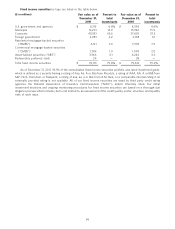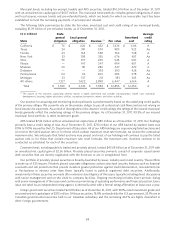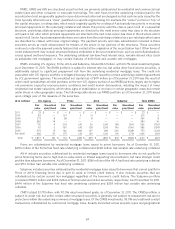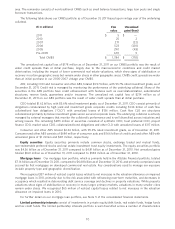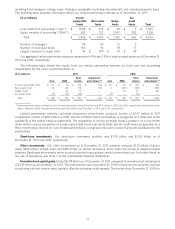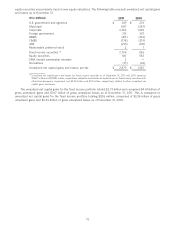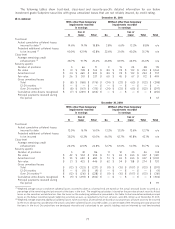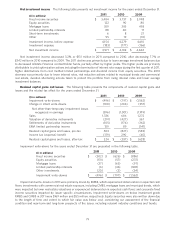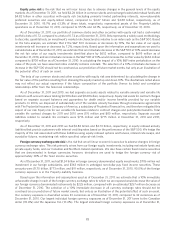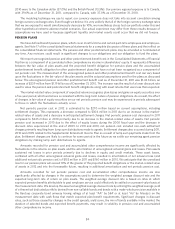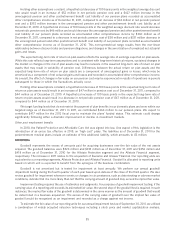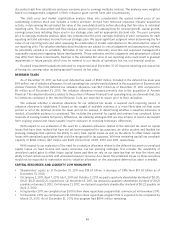Allstate 2012 Annual Report Download - page 162
Download and view the complete annual report
Please find page 162 of the 2012 Allstate annual report below. You can navigate through the pages in the report by either clicking on the pages listed below, or by using the keyword search tool below to find specific information within the annual report.and lower valuations. For our below investment grade Subprime with gross unrealized gains totaling $5 million, we have
recognized cumulative write-downs in earnings totaling $123 million as of December 31, 2011.
The credit loss evaluation for Subprime securities with gross unrealized losses is performed in two phases. The first
phase estimates the future cash flows of the entire securitization trust from which our security was issued. A critical
part of this estimate involves forecasting default rates and loss severities of the residential mortgage loans that
collateralize the securitization trust. The factors that affect the default rates and loss severities include, but are not
limited to, historical collateral performance, collateral type, transaction vintage year, geographic concentrations,
borrower credit quality, origination practices of the transaction sponsor, and practices of the mortgage loan servicers.
Current loan-to-value ratios of underlying collateral are not consistently available and accordingly they are not a primary
factor in our impairment evaluation. While our projections are developed internally and customized to our specific
holdings, they are informed by and benchmarked against credit opinions obtained from third parties, such as industry
analysts, nationally recognized credit rating agencies and an RMBS loss modeling advisory service. The default rate and
loss severity forecasts result in an estimate of trust-level projected additional collateral loss.
We then analyze the actual cumulative collateral losses incurred to date by the securitization trust, our projected
additional collateral losses expected to be incurred and the position of the class of securities we own in the
securitization trust relative to the trust’s other classes to determine whether any of the collateral losses will be applied
to our class. If our class has remaining credit enhancement sufficient to withstand the projected additional collateral
losses, no collateral losses will be realized by our class and we expect to collect all contractual principal and interest of
the security we own. Remaining credit enhancement is measured in terms of (i) subordination from other classes of
securities in the trust that are contractually obligated to absorb losses before the class of security we own and (ii) the
expected impact of other structural features embedded in the securitization trust beneficial to our class, such as
overcollateralization and excess spread.
For securities where there is insufficient remaining credit enhancement for the class of securities we own, a
recovery value is calculated based on our best estimate of future cash flows specific to that security. This estimate is
based on the contractual principal payments and current interest payments of the securities we own, adjusted for actual
cumulative collateral losses incurred to date and the projected additional collateral losses expected to be incurred. This
estimate also takes into consideration additional secondary sources of credit support, such as reliable bond insurance.
For securities without secondary sources of credit support or for which the secondary sources do not fully offset the
actual and projected additional collateral losses applied to them, a credit loss is recorded in earnings to the extent
amortized cost exceeds recovery value.
75.3%, 20.9% and 3.8% of the fair value of our below investment grade Subprime securities with gross unrealized
losses were issued with Aaa, Aa and A original ratings and capital structure classifications, respectively. As described
previously, Subprime securities with higher original ratings typically have priority in receiving the principal repayments
on the underlying collateral compared to those with lower original ratings. While the projected cash flow assumptions
for our below investment grade Subprime securities with gross unrealized losses have deteriorated since the securities
were originated, as reflected by their current credit ratings, these securities continue to retain the payment priority
features that existed at the origination of the securitization trust.
76


